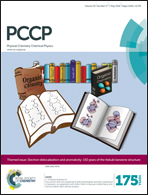Decay rate of real space delocalization measures: a comparison between analytical and test systems
Abstract
We examine in this contribution the possible relation between the spatial decay rate of real space delocalization measures and the insulating- or metallic-like character of molecular and extended systems. We first show that in simple one-electron models, like the Hückel or tight binding approximations, delocalization indices (DIs) are intimately linked to the first-order reduced density matrix (1RDM), whose decay rate is known to be exponential in gapped systems and algebraic in gapless ones. DIs are shown to behave equivalently, with wild oscillations in gapless 1D, 2D and 3D models that do only persist in one-dimensional real cases, as computed at the Hartree–Fock or Kohn–Sham levels. Oscillations are shown to be directly related to Pauling resonant structures and chemical mesomerism. DIs in insulating-like moieties decay extremely fast. We propose that examining the decay of DIs along different directions in real materials may be used to detect facile and non-facile conductivity channels.

- This article is part of the themed collection: Electron delocalization and aromaticity: 150 years of the Kekulé benzene structure

 Please wait while we load your content...
Please wait while we load your content...